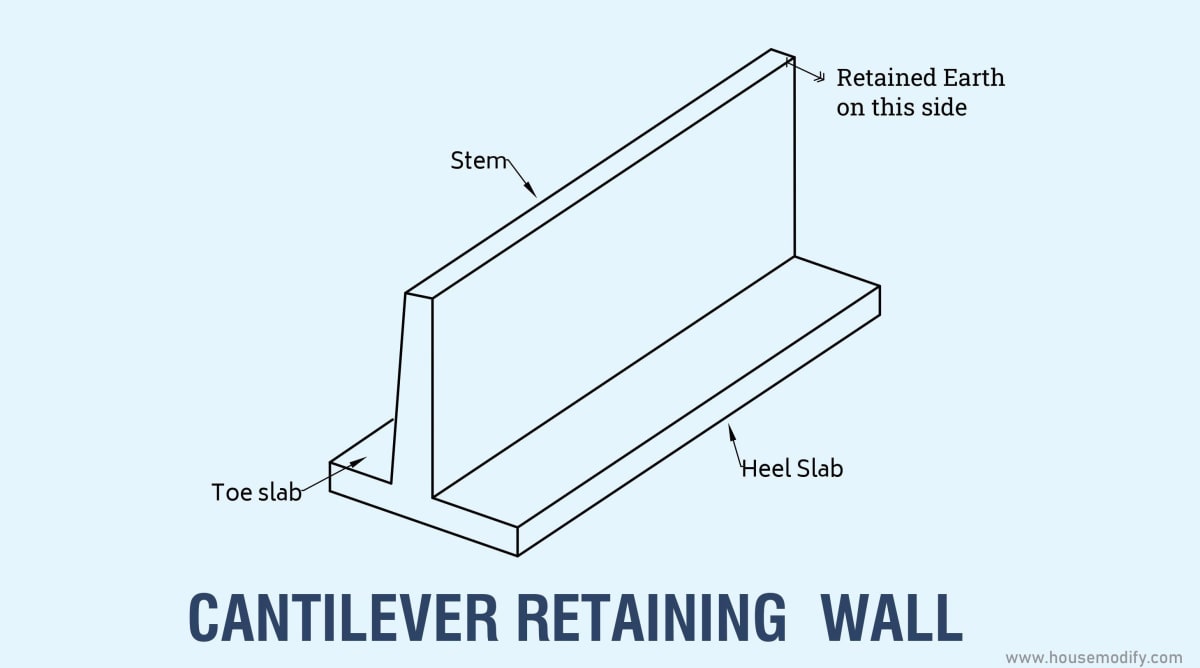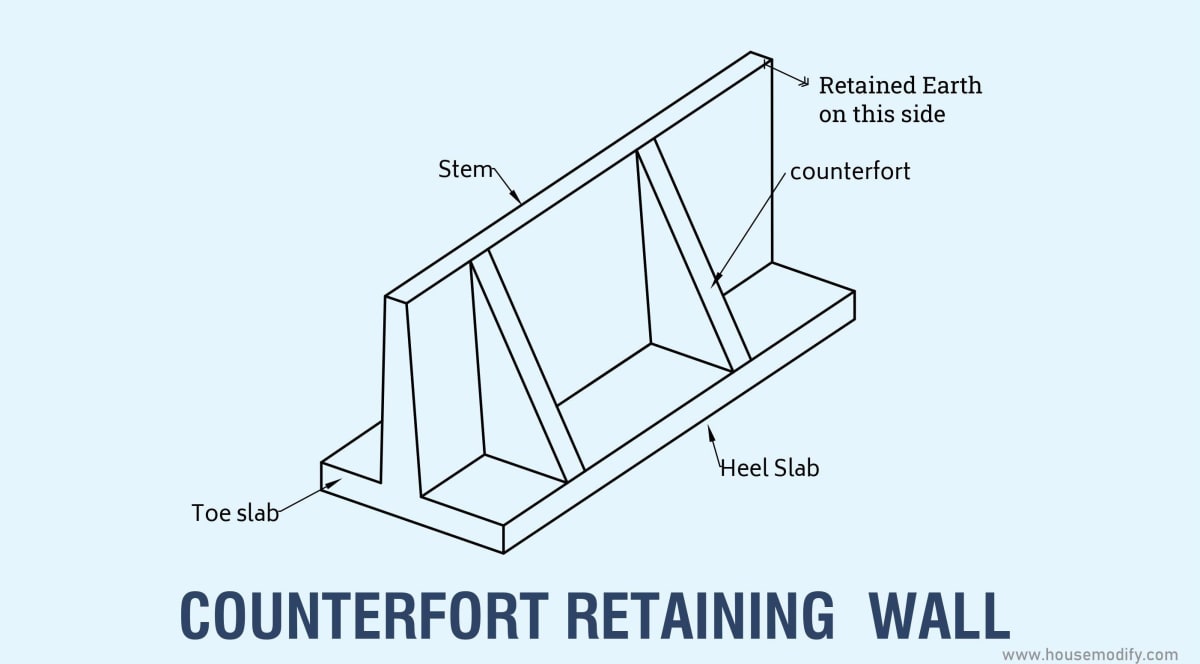The most common examples of the retaining wall are the Cantilever Retaining Wall and Counterfort Retaining Wall.
Retaining walls serve a critical function in construction as they are used to stabilize slopes against erosion & level the ground for various reasons.
Although each serves a common purpose, they vary much in their construction, design, and appliances.
This article discusses the main difference between Cantilever and Counterfort Retaining Walls to use in particular situations and locations.
Cantilever Retaining Wall Vs Counterfort Retaining Wall:

What is a Cantilever Retaining Wall?
A cantilever retaining wall is a short structure consisting of a thin wall referred to as the stem, which is usually connected to a horizontal slab or plate called its footing.
The wall goes deeper into the soil, where it rests on a more robust base material.
Such a design is efficient in terms of distributing the loads, thereby avoiding bulk footings at lower costs.

Advantages of Cantilever Retaining Wall:
Here are some of the benefits of Cantilever Retaining Walls as follows:
1. Cost-Effective:
They require fewer materials for construction purposes compared to any other method under consideration.
2. Sleek Appearance:
As contemporary designs, Cantilever Retaining Walls give your house a touch of style that could fit in the building of a mall or any other structure.
3. Reduced Environmental Impact:
Efficient use of space and materials makes it possible for a Cantilever Retaining Wall to produce less impact on the environment than other retaining walls.
4. Ease of Construction:
The building of such walls requires relatively more straightforward techniques compared with others, including well-maintained documentation.
5. Low Maintenance:
These walls are designed to require minimal advancement, thereby saving on maintenance costs over the lifetime of the structure.
Disadvantages of Cantilever Retaining Wall:
Here are some of the disadvantages and challenges associated with Cantilever Retaining Walls as follow:
1. Complex Design and Engineering:
Structural & geotechnical considerations are necessary while designing cantilever retaining wall compared to counterfort retaining walls.
2. Construction Challenges:
The process of building them still calls for adequate engineering and construction methods.
3. Material and Labor Costs:
These walls are cost-efficient because they optimize material utilization, but the quality of material and lab involved could affect the total project expenditure.
Applications of Cantilever Retaining Wall:
Cantilever Retaining walls can also be employed in different situations.
1. Residential:
They can be utilized in the landscaping of a garden or terracing to prevent soil slippage in residential construction and so on.
2. Commercial:
In a commercial project, they are used for holding water from stormwater management, support the foundations, and preservation of natural landscapes.
3. Infrastructure:
This system includes the construction of highways and railway embankments.
What is Counterfort Retaining Wall?
Counterfort retaining walls have vertical stanchions/or buttresses regularly placed on the wall’s length.
The “counterforts” are linked with a horizontal slab or footing running below the ground level.
This central wall, also referred to as “stems,” ties together the counterforts to form the main retaining element of the dam.

Advantages of Counterfort Retaining Wall:
There are several advantages to using counterfort retaining walls:
1. Structural stability:
The load carried by counterforts makes the retaining wall more stable as it spreads the laterally loaded forces better.
2. Cost-effective:
Using counterforts would be cheaper because less thick walls would mean less material, and forces would be distributed efficiently.
3. Easy to construct:
The use of precast components speeds up construction time, but their walls are generally easier to build compared to some retaining wall types.
4. Durability:
The concrete counterfort-reinforced structure is strong and has a higher duration than other materials.
5. Low maintenance:
However, it should be noted that after the completion of these counterfort retaining walls, the maintenance needs are usually limited.
6. Eco Friendly:
These retaining walls have drainage systems that help divert the water flows; otherwise cause more erosions.
Disadvantages of Counterfort Retaining Wall:
Some of the disadvantages of counterfort retaining walls include:
1. Speed Requirements:
The space for the back of the countertop walls is excessive.
2. Aesthetic Constraints:
The retaining structures are not attractive like other gravity walls and segmental block retaining walls.
3. Construction Complexity:
Building processes for counterfort retaining walls are extended with more serious engineering and quality.
4. Environmental Impact:
The counterfort retaining wall may pose many potential harmful environmental effects including disrupting the natural conditions surrounding it.
5. Maintenance of Drainage System:
Counterfort walls have a drainage system, and it drains off the water from a space.
6. Limited to specific height ranges:
Suitable for medium to high counterfort retaining walls.
7. Site-specific factors:
The overall performance of a counterfort retaining wall depends on site conditions like soil properties, groundwater level, and seismicity order.
Applications of Counterfort Retaining Wall:
Some of the primary applications of counterfort retaining walls include:
1. Highway and roadway embankments:
Counterfort retaining walls support dams along with roads on hilly or mountainous terrains.
2. Railway embankments:
Counterfort retaining walls are just like highways that provide safety of soil movements on railway inclines.
3. Commercial and industrial developments:
It is usually used in cases of high commercial-industrial construction.
It provides flat bases on earth in favor of buildings or other buildings.
4. Residential developments:
Counterfort retaining walls may be employed in domestic building projects for creating level terraces or supporting slopes.
5. Water retention structures:
Water retention systems like reservoirs or water treatment facilities may use counterfort walls for containing and regulating the movement of water.
6. Bridge abutments:
In addition, counterfort retaining walls are often used as bridge abutments to create stable pathways.
7. Airport runways and taxiways:
Such walls are essential in airport construction, where they provide a level plane for runway, taxiway, and other airport infrastructure.
Also read: Difference between Shear Wall and Retaining Wall
What is the Difference between Cantilever and Counterfort Retaining Wall?
Now, let’s directly compare the critical differences between cantilever and counterfort retaining walls:
| Feature | Cantilever Retaining Wall | Counterfort Retaining Wall |
|---|---|---|
| Stem | Straight. | Straight. |
| Thickness | Uniform. | Uniform. |
| Height | Up to 25 feet. | More than 25 feet. |
| Counterforts | Not present. | Present. |
| Structural Action | The stem and base slab withstand pressure and other forces. | The stem and base slab withstand pressure and other forces. |
| Design | This wall is like a counterfort wall. The stem is thinner than its counterpart. | This wall consists of thin vertical concrete webs (counterforts) at regular intervals along the back of the wall. |
| Economical Height | Economical below 6-7 m height. | Economical above 7 m high. |
| Stress Distribution | Uniformity of stress is not maintained. | Uniformity of stress is maintained. |
Also read: Difference between Normal Wall and Retaining Wall
Frequently Asked Questions (FAQs):
1. Can I use Cantilever Retaining Walls for a tall slope?
Yes, cantilever retaining walls can be used on moderately high slopes.
However, the retaining walls suitable for tall slopes are counterfort retaining walls.
2. Are these walls suitable for residential projects?
Although both Cantilever and Counterfort Retaining Wall can be applied as residential landscaping, cantilever walls are preferable because of low construction costs.
3. What is the main difference between Cantilever and Counterfort Retaining Walls?
The main difference lies in their design.
Cantilever walls have a T-shaped cross-section, while Counterfort walls have vertical slabs (counterforts) on the soil.
4. How do I determine which type of retaining wall is best for my project?
This is influenced by the height of the walls, the nature of the soils, and the available money for funding.
Getting a professional estimation from a qualified structural engineer would be helpful.
5. Do these walls require regular maintenance?
The maintenance needs for both types of walls is minor.
However, regular checkups for indications of damages and ground displacements are recommended.
6. Can I use alternative materials for construction?
The reinforced concrete is the most common material in some instances, other building materials such as timber and steel might be considered depending upon the specific requirements for a project as well as cost considerations.
Also read: Difference Between Buttress and Counterfort Retaining Wall
Conclusion:
Cantilever and counterfort retaining wall are essential for construction and civil engineering activities.
Cantilever walls are relatively inexpensive and work well for medium-height applications but may need to be improved for tall structures.
Counterfort walls are highly stable and can be incorporated into tall structures.
However, the selection of any wall is based on specific project requirements and existing soil conditions.
Section Under: Retaining Walls








